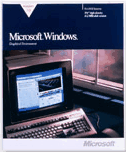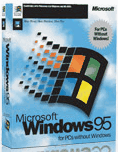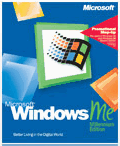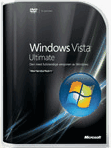Windows Evolution ~ History line of Windows from beginning to Windows 7.
As we all know that Windows 7 is going to be launched after two days on 22nd of October. So lets have an overview of the Windows history starting from the Windows 1.0 to Windows Se7en.
Windows 1.0
Release Date 1985

The first version of Windows provided a new software environment for developing and running applications that use bitmap displays and mouse pointing devices. Before Windows, PC users relied on the MS-DOS® method of typing commands at the C prompt (C:\). With Windows, users moved a mouse to point and click their way through tasks, such as starting applications.
In addition, Windows users could switch among several concurrently running applications. The product included a set of desktop applications, including the MS-DOS file management program, a calendar, card file, notepad, calculator, clock, and telecommunications programs, which helped users manage day-to-day activities.
Windows 2.0
Release Date 1987

Windows 2.0 took advantage of the improved processing speed of the Intel 286 processor, expanded memory, and inter-application communication capabilities made possible through Dynamic Data Exchange (DDE). With improved graphics support, users could now overlap windows, control screen layout, and use keyboard combinations to move rapidly through Windows operations. Many developers wrote their first Windows–based applications for this release.
The follow-up release, Windows 2.03, took advantage of the protected mode and extended memory capabilities of the Intel 386 processor. Subsequent Windows releases continued to improve the speed, reliability, and usability of the PC as well as interface design and capabilities.
Windows 3.0
Release Date 1990

The third major release of the Windows platform from Microsoft offered improved performance, advanced graphics with 16 colors, and full support of the more powerful Intel 386 processor. A new wave of 386 PCs helped drive the popularity of Windows 3.0, which offered a wide range of useful features and capabilities. The popularity of Windows 3.0 grew with the release of a new Windows software development kit (SDK), which helped software developers focus more on writing applications and less on writing device drivers. Widespread acceptance among third-party hardware and software developers helped fuel the success of Windows 3.0.
Windows for Work groups 3.11
Windows for Workgroups 3.11 added peer-to-peer workgroup and domain networking support. For the first time, Windows–based PCs were network-aware and became an integral part of the emerging client/server computing evolution. Windows for Workgroups was used in local area networks (LANs) and on standalone PCs and laptop computers. It added features of special interest to corporate users, such as centralized configuration and security, significantly improved support for Novell NetWare.
Windows 95
Release Date 1995

Windows 95 integrated a 32-bit TCP/IP (Transmission Control Protocol/Internet Protocol) stack for built-in Internet support, dial-up networking, and new Plug and Play capabilities that made it easy for users to install hardware and software. The 32-bit operating system also offered enhanced multimedia capabilities, more powerful features for mobile computing, and integrated networking.
Windows 98
Release Date 1998

Windows 98 was the upgrade from Windows 95. Described as an operating system that "Works Better, Plays Better," Windows 98 was the first version of Windows designed specifically for consumers.
With Windows 98, users could find information more easily on their PCs as well as the Internet. Other ease-of-use improvements included the ability to open and close applications more quickly, support for reading DVD discs, and support for universal serial bus (USB) devices.
Windows ME
Release Date 2000

Designed for home computer users, Windows Me offered consumers numerous music, video, and home networking enhancements and reliability improvements.
For example, to help consumers troubleshoot their systems, the System Restore feature let users roll back their PC software configuration to a date or time before a problem occurred. Windows Movie Maker provided users with the tools to digitally edit, save, and share home videos. And with Microsoft Windows Media® Player 7 technologies, users could find, organize, and play digital media easily.
Windows 2000
Release Date 2000

Built on top of the proven Windows NT Workstation 4.0 code base, Windows 2000 added major improvements in reliability, ease of use, Internet compatibility, and support for mobile computing. Among other improvements, Windows 2000 Professional simplified hardware installation by adding support for a wide variety of new Plug and Play hardware, including advanced networking and wireless products, USB devices, IEEE 1394 devices, and infrared devices.
Windows XP Professional
Release Date 2001

Windows XP Professional brings the solid foundation of Windows 2000 to the PC desktop, enhancing reliability, security, and performance. With a fresh visual design, Windows XP Professional includes features for business and advanced home computing, including remote desktop support, an encrypting file system, and system restore and advanced networking features. Key enhancements for mobile users include wireless 802.1x networking support, Windows Messenger, and Remote Assistance.
Windows Vista Ultimate
Release Date 2007

The most complete edition of Windows Vista—with the power, security, and mobility features that you need for work and all of the entertainment features that you want for fun.
Windows Vista Ultimate is the choice for those who want to have it all. Easily shift between the worlds of productivity and play with the most complete edition of Windows Vista. Ultimate provides the power, security, and mobility features needed for work, and all the entertainment features that you want for fun.
Windows 7
Release Date 2009

It is more reliable, more responsive, and to make the things consumers do every day easier, which Windows 7 was built around consumers' feedback.
Windows 7 works the way businesses want. It makes users productive anywhere, delivers enhanced security and control to reduce risk, and streamlines PC manageability to reduce costs. It is also the best operating system for work and home. Windows 7 Professional works the way customers want, enables customers to get more done and safeguards their work.
Unlock Windows
Search
Subscribe
Translator
Popular Posts
Blog Archive
- March 2011 (3)
- February 2011 (2)
- January 2011 (4)
- December 2010 (13)
- November 2010 (7)
- October 2010 (7)
- September 2010 (1)
- August 2010 (2)
- July 2010 (3)
- June 2010 (8)
- May 2010 (18)
- April 2010 (12)
- March 2010 (15)
- February 2010 (9)
- January 2010 (15)
- December 2009 (21)
- November 2009 (28)
- October 2009 (35)
- September 2009 (14)
- August 2009 (23)
- July 2009 (19)
- June 2009 (20)
- May 2009 (12)
- April 2009 (18)
- March 2009 (8)
- February 2009 (7)
- January 2009 (14)
- December 2008 (16)
Labels
- Anti Virus
- Apple
- Beta Products
- Bing
- Bugs
- Creativity
- Download Center
- Ebooks
- Events
- Expression
- Games
- Internet Explorer
- Keyboard Shortcuts
- Microsoft Hardware
- Microsoft Office
- Microsoft Research
- News
- Offers
- Review
- Security
- Silverlight
- Software
- SQL Server
- Themes
- Tips 'n' Tricks
- Unsorted
- Visual Studio
- Wallpapers
- Windows 7
- Windows 8
- Windows Live
- Windows Mobile
- Windows Phone
- Windows Server
- Windows Vista
- Windows XP
- Zune
Friends
About Me
- Arvind Kumar
- I'm Arvind Kumar from India, B.Tech, now working in a MNC. I love to use Microsoft Products and learn from that. Bill Gates is my ideal person.






0 comments:
Post a Comment